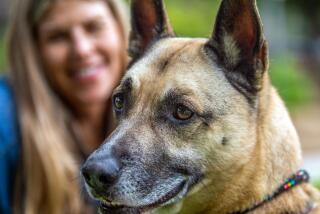A Dog’s Life : Illness Still Hounds Buffer After Rare Operation
- Share via
Buffer, the Labrador retriever and constant companion of an Escondido quadriplegic, was alert, hungry and barking after unusual laser brain surgery in Orange County on Friday, but the operation did not go as planned.
Dr. James Boggan, a UC Davis neurosurgeon who flew to UC Irvine’s Beckman Laser Institute and Medical Clinic to donate his services for the procedure, said that when the Buffer’s skull was opened and the tumor was exposed, “unfortunately we did not find the abnormality we expected to find.”
The growth--originally diagnosed after a CAT scan as a benign but fast-growing meningioma tumor--was not growing outside the brain but instead “originated from the brain itself,” said Boggan, who was assisted during the two-hour operation by a veterinary surgeon.
Boggan could not remove much of the growth because he would have risked cutting through healthy brain tissue and causing severe brain damage, he said. Instead, primarily a biopsy was performed.
Results from the biopsy will determine what kind of treatment--possibly radiation or chemotherapy--might help the dog, who has been suffering severe seizures for four months.
Debra Cohen, licensed animal health technician at Newport Beach Veterinary Hospital, where the dog is getting care, said: “It would have been really nice to have had a happy ending. It would have been wonderful. If it had been a meningioma, they could have done some great good.
“We’re not back to square one. We’re at a more educated square two.”
The dog’s owner, real estate agent Anthony Pizzo of Escondido, has spent about $2,000 so far on treatment for Buffer--so named because of his shiny coat and Pizzo’s job as a woodshop teacher when he got the pup 10 years ago.
“But you can’t put a price on a pet’s companionship and love,” Pizzo has said. Buffer had accompanied Pizzo on cross-country trucking trips, which ended in 1979 in an accident that left Pizzo paralyzed. Since those injuries forced him into a wheelchair, Pizzo said, Buffer had become a true companion.
When Buffer began suffering severe seizures in late March, Pizzo took him to a San Diego veterinarian, who referred the dog to veterinarian Jeffrey Cohen, who specializes in internal medicine at the Newport Beach Veterinary Hospital.
Cohen ordered the CAT scan at the Huntington Research Institute in Pasadena, which diagnosed the meningioma tumor and determined that conventional surgery was impossible because the growth was surrounded by so many blood vessels.
But laser surgery reduces the risk of excessive bleeding. The high-intensity beam of light automatically cauterizes vessels as it slices through tissue, said Debra Cohen, the veterinarian’s wife.
Pizzo said he chose the drastic procedure because Buffer has been “a real faithful pet” who deserved better than to live out the rest of his life doped on drugs. Once a lively dog that used to leap into Pizzo’s lap every morning for an exuberant greeting, the Labrador has grown fat and dull and must be confined to the backyard because of the effects of medication.
Although Boggan had performed the brain surgery before several times on animals in Davis and the San Francisco Bay Area, this was the most ambitious veterinary procedure attempted at the year-old Beckman Institute, a research and medical treatment facility, a spokeswoman said. The Beckman Institute is one of just a handful of facilities in the state that makes laser technology available to veterinary medicine, she said.
Once he exposed the growth, Boggan saw that it was not a meningioma, which originates from the covering of the brain. The tumor instead was growing from the brain itself, and “I could not differentiate between the abnormal tissue and the normal tissue.”
Soon after the operation, however, Buffer was on the rebound.
“He’s up, alert and didn’t even know he had surgery,” Debra Cohen said. There was no brain swelling and no facial paralysis, which had been a possibility even if the surgery had been successful.
Buffer’s future depends on the pathology report, expected next week, she said. Boggan has recommended that the dog undergo another CAT scan before treatment begins.
Besides radiation or chemotherapy, a third treatment could involve injecting the tumor with a light-sensitive dye, then shining a laser on it that destroys the dye-soaked abnormal tissue, she said.
Pizzo said Friday afternoon that he expects to have Buffer pursue further treatment.
“I thought I could get it over with today and take my dog home,” he said. “But I’ve gone this far, I’ve got to talk to them about the possibilities of him still being helped.
“If the chances are good, I’ll go through with it.”
More to Read
Sign up for Essential California
The most important California stories and recommendations in your inbox every morning.
You may occasionally receive promotional content from the Los Angeles Times.













